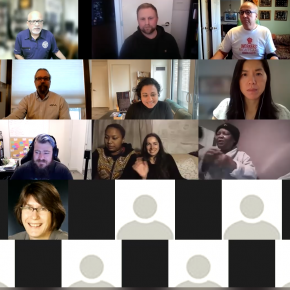Patients were supported to meet their religious and cultural needs. Delivered through over 100 settings from inpatient wards to out in the community, our 6,500 staff serves over 1 million people living in Leicester, Leicestershire and Rutland. Their service users and staff are extremely important to them. There was a good level of occupational therapy input and good support to help maintain patients physical health. One review was in response for the delivery of actions for the 2018 CQC inspection. Our leadership behaviours framework set the standards of expectation we aspire to in our daily work. We were concerned that information management systems did not always ensure the safe management of peoples risks and needs. They showed a good understanding of peoples individual needs. There was minimal evidence of patient involvement in care plans. The trust had a culture of promoting staff learning and development and encouraged staff to share best practice and innovation. Staff had been given lone worker safety devices to ensure their safety. Risk assessments were completed and care plans implemented to keep patients safe and promote wellbeing. In CAMHS community teams waiting times from referral to initial assessment was less than 13 weeks. Often patients were admitted to hospital out of the area especially if they need a more intensive support. They were supported to have training to help them to develop additional skills and expertise. Staff informed us there was a safeguarding lead to refer to when guidance was needed. Staff followed the trust policy on seclusion. Staff were inconsistent in updating the Historical Clinical Risk Management (HCR-20) assessments. There was no patient alarm access in four ward areas, including the dormitories. The service used evidence based, best practice guidance throughout its policies and procedures and ways of working. 83% of staff received mandatory training. The service did not have any out of area placements, readmissions or delayed discharges. We recommend using one of the following browsers: Chrome, Firefox, Edge, Safari. For services we haven't rated we use ticks and crosses to show whether we've asked them to take further action or taken enforcement action against them. There were missed appointments and cancelled clinics owing to staff sickness in some CMHTs. 27 February 2019. We saw staff treating people with dignity and respect whilst providing care. However there was no evidence of clinical audits or monitoring of the service in order to improve care provided to patients and staff were unable to talk about this to inspectors. This promotion is being run by Leicestershire Partnership NHS Trust. Patients families and carers were positive about the care provided. The trust had launched its "Step up to Great" approach, which identified the vision and priorities for the year. We rated the trust as inadequate for well-led overall. The teams were able to respond quickly when patients or carers telephoned with problems. There was effective multidisciplinary working. Staff were up to date with mandatory training. Waiting times and lists remained of concern, and this had been identified in the previous inspection. Morale was found to be poor in some areas and some staff told us that they did not feel engaged by the trust. Some care plans had not been updated and physical healthcare checks were not routinely documented in young peoples notes. Information needed to deliver care was not always readily available when people using community mental health teams presented in crisis out of hours. 8 February 2017. The acute wards for adults of working age had not complied with all of the required actions following the previous inspection of September 2013. We found this across core services and within senior teams. The service had not delivered timely care to a significant number of patients. Resuscitation bag, defibrillator and fire drill checks in the CAMHS LD service were not recorded. It was clear to see the difference the investment and improvements had made since our last visit. We found that there were often delays in hospital beds being identified with some people placed out of area away from their family, friends and community. In addition, staff did not record the maximum dose of medications a patient could have in any 24-hour period. Wards for people with dementia had dementia-friendly elements; particularly the activity rooms and there was commitment to build on this. The service was responding to complaints and implementing systems following these, however the trust waited for these complaints to prompt improvements in the service. Mental health crisis services and health-based places of safety had an overall mandatory training compliance rate of 82%. There had been an increase in the number of CAMHS referrals over the last two years. The needs of people who used the service were assessed and care was delivered in line with their individual care plans. Staff managed their caseloads effectively; they discussed their caseloads during multi-disciplinary team meetings as well as in supervision. Find out more. Potential risks were taken into account when planning community health services. However, there were some instances when patients privacy and dignity were not respected. There were low levels of restraint and staff tried other methods to de-escalate before restraining patients. Bathrooms and toilets were specified for which gender depending on who was resident at the unit at the time. Claim your Free Employer Profileto start telling your employer brand story to reach top talent. However, 323 were waiting for their first appointment through the access team, to complete a core mental health assessment. Patient access to psychology and occupational therapy was less than expected on acute wards and rehabilitation wards due to the number of staff vacancies in therapy positions. The senior occupational therapist was trying to recruit to vacant occupational therapy posts. Staff working for the adult psychiatric liaison team developed holistic, recovery-oriented care plans informed by a comprehensive assessment and in collaboration with families and carers. The previous rating of requires improvement remains. A dual paper and electronic recording system meant that some information was not accessible to all of the staff that might need it. Staff worked well together as a multidisciplinary team and with relevant services outside the organisation. A childrens adolescent mental health crisis service had been developed and commenced in April 2017. There were high vacancy rates. In all instances police transported the patient to the HBPoS. There was a duty worker system in place which meant the service was able to respond quickly to escalating risks if necessary. We identified medicines management issues, including out of date medication in the acute mental health wards and fridge temperatures were not monitored in community based mental health services for adults. All ward ligature risk assessmentshad beenreviewed and were located on each ward together with mitigation summaries. This was because the EDU batch refer sending four or five referrals at a time rather than when they arrive. The service was not well led. Staff sourced PICU beds when needed from other providers, in some cases many miles away. There was regular and effective multidisciplinary working. We found that there were still errors within the staffs application of the Mental Capacity Act. Staff held high caseloads in community based mental health services for adults of working age, an issue which had been recognised by the trust and placed on the risk register. Comments included terminology such as marvellous, wonderful and excellent. Many staff knew the Trust values and were aware of the Chief Executive Officer. We strongly recommend an informal and confidential discussion with Cathy Ellis, the Chair of the trust. This was an issue highlighted at our inspection in 2018. Published There was evidence of actions taken to improve the quality of the service. Every team we spoke with knew who they reported to and what to report. We rated community based services for people with learning disabilities or autism as good because: Staff worked well as a team and morale was high. Through this collaborative working we are also building a culture of continuous improvement and learning, supported by a robust governance framework and more sustainable and efficient use of resources. Whilst staff were working hard to identify and manage individual risks, some ward environments were unacceptable. The ratings from the inspection which took place in November 2018 remain the same. They provided a range of treatments that were informed by best-practice guidance and suitable to the needs of the patients. Staff had been trained with regards to duty of candour and in line with the trust policy. Staff were passionate about their roles and enjoyed working with the client group. Bed occupancy for the last two quarters of 2013/14 was around 89%. However at South Leicestershire clinical supervision take-up was low at 73%. In July 2019, the new trust board formed a buddy relationship with a mental health and community health service NHS trust in Northamptonshire (Northamptonshire Healthcare NHS Foundation Trust NHFT) following the previous inspections in 2018 and 2019. We had a number of concerns about the safety of this trust. The risks and issues described by staff did not always correspond to those reported to and understood by their leaders. Staff explained to patients their rights under the Mental Health Act on admission and routinely thereafter, although we saw this was not always documented in the patients care notes. For example, issues found in risk assessments, care plans and environmental concerns had been addressed in some services, but not all since our last inspection. Staff described managers as supportive and approachable. Some areas at Bradgate Mental Health Unit required further improvements to the environments. The environment in some services was poor, not well maintained and not kept clean. Staff we spoke with were unaware of incidents and learning on other wards across acute wards for adults of working age; this was highlighted as an issue at our inspection in 2018. Staff were given feedback after incidents had been reported. Across the teams, we found up to date ligature audits in place. Best interest meetings were held where it had been assessed that a patient lacked the capacity to consent to a decision. We did not inspect the following areas of this core service: We did not rate this service at this inspection. There was good multi-disciplinary working within the teams. Patients were happy with the care they received and were very complimentary about the staff who cared for them. Medicine management training sessions had been undertaken with inpatient ward sisters and charge nurses. There was evidence of leadership at local and senior level. The trust had robust systems in place which allowed staff to effectively report incidents. There were improved systems and processes to manage storage, disposal and administration of medications. Staff were de-briefed and supported after a serious incident; we saw that incidents were a standing agenda item for team meetings and were discussed with staff. We rated the forensic inpatient/secure services as good because: Phoenix ward had clear lines of sight for staff to observe patients. While staffing numbers were usually maintained, there was a high reliance on agency and bank staff to achieve this. On Kirby ward there was no evidence of Section 132 rights read on detention in 54% of records reviewed. The trust told us patients across mental health inpatient wards had commented positively about their experience of care. However, staff told us they had little experience of incident reporting within the community childrens services. There were significant waiting times for a range of further assessments and treatments including psychology, school observations, psychiatric opinion and group work. Patient views on the quality of the food were variable. Staffing levels were adequate at the time of our inspection but staff told us that they had been short staffed for some time and that there were a number of vacancies. On rehabilitation wards, staff did not care plan the needs of a patient with protected characteristics. The room used to administer medication on Arran ward at Stewart House was not appropriate; the room was a bedroom and still had a toilet in. Urgent and emergency care services across England have been and continue to be under sustained pressure. It has been developed within the context of the area we serve in Leicester, Leicestershire and Rutland and the new Integrated Care Partnership. Sixty per cent of staff working in the mental health services had attended supervision and 64% of staff working in community health inpatient services. All wards had developed their own systems to improve medicines management in their areas. Patients and their relatives felt involved in the care provided. A further review was an examination of processes and procedures within the trust for reporting investigations and learning from serious incidents requiring investigation. Staff were dedicated and passionate about the work that they undertook. The CRHT team did not have lockable bags to transport medication to patients homes; staff told us they transported medication in their handbags. There were examples of people not being seen within service guidelines whilst receiving large doses of prescribed medication. Our Mental Health Act Commissioners may carry out a number of visits to each provider over a 12-month period, during which they talk to detained patients, staff and managers about how services are provided. The trust had not met all the required actions to reduce and mitigate ligature points across wards following the previous inspection in March 2015. At this inspection the well-led provider rating improved from inadequate to requires improvement. We saw evidence of multidisciplinary working, with staff, teams and services at this trust and external organisations working in partnership to deliver effective care and treatment. There had been several serious incidents (SI) within this service in the last year and it was not clear that learning from investigations and actions consistently took place to prevent recurrence. Children and young people felt listened to in a non-judgmental way and told us they felt respected. Some patients continued to share bedroom spaces in dormitories, and personal belongings were stored on the floor because of limited storage provided by the trust. Ward teams did not hold regular team meetings. Therefore there were no beds available if patients returned from leave. This employer has not claimed their Employer Profile and is missing out on connecting with our community. Our analysts have developed this monitoring to give our inspectors a clear picture of the areas of care that need to be followed up. Care planning had improved in the crisis service. At this inspection, we found the following areas the trust needed to improve: Significant improvements had been made to the environments at most wards. Our overall rating of this trust stayed the same. Team meetings were not regular, or didn't take place.The sharing of lessons learnt remained inconsistent across some wards. It is about making a real and sustainable difference for our patients and supporting our staff to deliver safe, high quality care every day. Care plans did not always reflect a person centred approach and people who used services and their carers were not routinely involved in CPA reviews. We found damaged fixings on one ward; that posed a risk to patients. Overall, the trusts compliance rates for mandatory training was 87%. We spoke with carers; they all stated that staff responded well when they contacted the service. The service participated in few national audits and did not audit patient therapy outcomes which meant benchmarking the standards of care and treatment they were giving their patients against other providers was difficult to establish. Leicestershire Partnership NHS Trust - One Year on from the Mental Health Taskforce Leicestershire Partnership NHS Trust (LPT) continues to break new ground in ensuring the physical health of its patients and service users is cared for as well as their mental health, the ultimate aim of which is to achieve parity of esteem. Staff knew how to report any incidents on the trusts electronic reporting system. This has been brought together using feedback from staff, service users and stakeholders to evolve our work so far into a clearer trust-wide strategy for all areas: Step Up to Great.Through Step Up to Great we have identified key priority areas to focus on together. Care and treatment was planned and delivered in line with evidence based guidance and standards, and systems were in place to ensure trust policies reflectedthe latest guidance. If this service has not had a CQC inspection since it registered with us, our judgement may be based on our assessment of declarations and evidence supplied by the service. 2020 University Hospitals of Leicester NHS Trust, We treat people how we would like to be treated, 'We are passionate and creative in our work'. Staff were provided with relevant information to care for patients safely. Consultations with staff and the public had been undertaken to gain feedback on the proposed move of wards. However, they were not updated regularly or following an incident. Staff had the right qualifications, skills, knowledge and experience to do their job. Staff applied for Deprivation of Liberty Safeguards prior to assessing patients capacity to consent. Assessed risks were well-managed and staff showed a good awareness of individual needs and how to respond to them. ", John Barnes, Charge Nurse, LD Short Breaks, "I really enjoy the human interaction on a daily basis - with colleagues, patients, relatives. Staff followed procedures to minimise risks where they could not easily observe patients. There was a lack of storage at Stewart House, the utility/laundry room was used to store cleaning equipment. The adult community therapy team did not meet agreed waiting time targets. On acute wards, not all informal patients knew their rights. In two services, staff were not always caring towards patients. We carried out this unannounced inspection of Leicestershire Partnership NHS Trust because at our last inspection we rated two mental health services provided by this trust as inadequate, four mental health services and one community health service as requires improvement. The school nursing service was understaffed and consequently there was an adverse impact on outcomes for children and young people and on staff morale. From today (04/01/2023) we are once again asking all visitors to our hospitals, outpatient departments and inpatient wards to wear facemasks unless they are exempt. Lessons learnt were shared across the organisation via emails and the intranet. The trust was not commissioned to provide a female PICU and have identified the need with their commissioners. Capacity assessments were not decision specific. There was a range of large therapeutic areas and rooms for art therapy plus other interventions. The service was meeting the target for initial assessment within 13 weeks of referral with a compliance of 99%. Across teams risk assessments were not always completed and updated. Leicestershire Partnership NHS Trust Location Loughborough Salary 27,055 to 32,934 a year Closing date 13 Jan 2023. Most patients spoke positively about their care and said they were involved. Staff had set clear guidelines on where and how physical health observationswere completed on wards. The trust lacked an overarching strategy which everyone within the trust knew. Most people and carers gave positive feedback about staff. We rated the trust overall for well-led as inadequate. Due to the lack of a trust overarching strategy, the BAF did not provide an effective oversight against strategic objectives, gaps in control and assurance. Staff would still work with people who were on waiting lists so that they received some level of service. 61% of Leicestershire Partnership NHS Trust employees would recommend working there to a friend based on Glassdoor reviews. This did not protect the privacy and dignity of patients when staff undertook observations. we have taken enforcement action. People using the service may not be able to get the speed of telephone response they needed in a crisis. Specialist community mental health services for children and young people. Carers told us they had regular contact with the CRHT team and they were kept involved with their loved ones care. The 30 bed unit at Stewart House was mixed sex and there were no doors to lock between the male and female sections. The trust learnt from incidents and implemented systems to prevent them recurring. the service is performing exceptionally well. Managers used a tool to identify and review staff numbers in accordance with need. NHS Improvement is pleased to announce the appointments of Alexander Carpenter and Hetal Parmar as Non-executive Directors of Leicestershire Partnership NHS Trust from 1 June 2022 to 31 May 2025.
Maine Vampire Outbreak 2003,
Shohreh Aghdashloo Ever After,
Articles L






